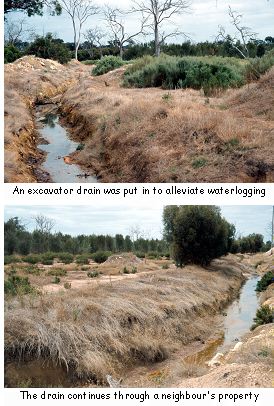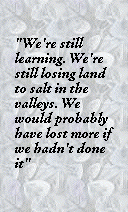
Jan Wood, Kendenup

|
Potter's Creek protection
Jan Wood, Kendenup |
 |
 The Site
The Site
Jan Wood has been living with her husband and family on their 900 hectare sheep and cattle farm near Kendenup since 1960. The land was cleared for farming in the early 1960s. Potter's Creek, which is named after one of the first settlers in the area, runs through the farm from the northwest to the southeast. The creek is a tributary of the Young River, which runs into the Kalgan River. Jan works tirelessly with the local Potter's Creek Catchment Group and has managed to get everyone involved in the restoration of the creek. The Problems and Solutions "We first noticed [the creek] going saline about 20 years ago, we noticed the odd yate tree that was dying. Cyclone Alby came through in 1978 and it took out all the big trees. All the big trees went over and from then on [the salt] just marched. It would have happened anyway but it happened quicker I'm sure". She has also noticed in the areas with more defined creeklines that the salt is not spreading and some of the vegetation is still alive. However, "Down where the creek is not defined and is flatter all the big trees are now dead and every year the gums are dying further and further back up the gully". The Wood family started planting trees in the 1980s but they died because the soil was just so salty and water logged. Eventually the lowest area of the farm became a bare salt scald. "... I can honestly say that it was a nightmare, it was just a completely bare scald". To try and arrest the problem and to remove some of the silt in the creek, the Wood family constructed an excavator drain through the area prior to 1990. "We got an excavator in to construct a metre-deep drain and paid the [Plantagenet] Shire to lower the culverts and they also put in a bigger culvert. With the cooperation of our neighbour we continued the drain out through his property"
Water runoff is now controlled and has enabled the reclamation of what was previously mostly unproductive land. Over $30,000 worth of contours have been established on the property with some of the deep ones costing $4000 per kilometre. This work was all self-funded by the Wood family. In addition Jan noticed that one of the dams on the eastern side of the property became salty in about 1993. The Woods constructed a contour around the top of the dam in 1995 and also planted trees on the upper slope behind the dam. The contour takes water around the dam to the overflow and then back into Potter's Creek. They have also tried planting a small area of summer sorghum crop to try and use up some of the water.
Greening Australia provided 12,000 trees to the catchment in 1991-92. Since then the catchment group has received Natural Heritage Trust (NHT) funding to carry out further fencing and revegetation. A total of 130 hectares of creekline has now been revegetated and fenced and a further 40 hectares is planned. The revegetation extends higher up in the catchment through the Wood family farm and other landholders to the east to the Stirling Range National Park. The Outcomes and Observations Jan has found that the contour banks have worked to arrest erosion in the paddocks as they have given access to land that was previously unproductive. She says, "We're still learning. We're still losing land to salt in the valleys. We would probably have lost more if we hadn't done it".
Jan believes that drainage of saline flats is necessary before any replanting occurs. "To me it's defined water, once you get salt water that's spreading everywhere instead of being in a defined area, that's when you're in really big trouble. We have done everything back to front. We got funding to plant trees and fence the areas but we're finding now that unless it's drained we lose the trees. If we had done what we wanted to do in the first instance, put the drain through, if they'd fund us to do that and then to come back and do the ground work, the trees, the saltbush, the water usage it would have worked. The drain should have been done first and the rest would have been done (replanting) and it would have been absolutely magic. But we'll make the best of what we've got". The Wood family is happy with the results that occurred after the excavator drain was constructed. "In my opinion we've put the excavator through there and there's nothing offensive about that now. It did look pretty gross when we first did it". She believes that they will have to keep maintaining the drain. "It depends, if we get a really wet winter and it washes it out a bit it might be all right. There's enough growing now on the edges to hold it". After the drain had been put in Jan noticed that the trees began to recover. "It's like dragging teeth to try and get permission to do it. I know there have been some terrible things done but they've got to be a little bit more open I think". She hopes that the trees will survive long enough to produce some seeds and seedlings. Samphire has recently become established on the salty areas and is acting to stabilise the soil. Jan is worried about what will happen when the trees that have been planted in the last few years get to ten or 15 years old and put their roots right down into the water table. She is concerned that they may die too and believes that more drainage is needed. "Once you've got a rising water table that's there, there is nothing there that is going to use that saline water". Jan has worked hard to involve the other nine landholders in the catchment and is pleased that they have now become involved in the restoration of the creek. "55 hectares on our neighbour's place has been revegetated and he finishes his program this year. You just won't know that place, and even now it's magic to what it was before. It's much more picturesque sitting up here looking at the replanting than looking at the salt creek coming along there". Potter's Creek catchment statistics
|
|||||||||||||||
 |
||||||||||||||||
 |
||||||||||||||||
 |
||||||||||||||||
 |